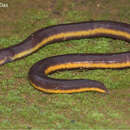Description
provided by AmphibiaWeb articles
Ichthyophis longicephalus has a mean total length of 270 mm. This caecilian has a total of 438 primary and secondary annuli, with eight of these on the tail (Pillai 1986). The annuli on the venter are broken at the mid-line, with the breaks forming a midventral line that extends from collar to vent (Bhatta 1998). Its body is broad and short, with a relatively long head (Bhatta 1998). The eyes are distinct and the tentacular aperture is situated close to the lip, much nearer to the eye than the nostril (Bhatta 1998). Tentacles are conically shaped and long (Bhatta 1998). Nostrils are roughly terminally positioned and can be seen from above (Bhatta 1998). Ichthyhophis longicephalus has an average of 46 premaxillary-maxillary teeth, about 40 dentary teeth, and about 17 splenial teeth (Pillai 1986). The mouth is terminal and the snout extends slightly further than the mouth, giving them the long head referred to in the specific name longicephalus. The tongue is narrow, anteriorly striated, and nearly completely covered in splenials (Pillai 1986). The first nuchal groove is distinguishable from the ventral and lateral side, but is not distinct from the dorsal side (Bhatta 1998). The second nuchal groove is distinguishable ventrally, and extends laterally to the level of the angle of the mouth (Bhatta 1998). The first and second collars are fused on the dorsum, with the second collar having two incomplete dorsal folds (Bhatta 1998). The tail is short and pointed, and the vent is longitudinal (Bhatta 1998).Dorsal coloration is a dark violet brown and the ventrals are lighter in color (Bhatta 1998). A yellow lateral stripe runs from the posterior edge of the second nuchal collar to the tail tip (Bhatta 1998). The vent is surrounded by a whitish spot (Pillai 1986). Yellow blotches are visible at the angle of the jaw, and on the sides of the first and second collars (Bhatta 1998).
- Pillai, R. S., and Ravichandran, M. S. (1999). ''Gymnophiona (Amphibia) of India. A taxonomic study.'' Records of the Zoological Survey of India, Occasional Papers, 72, 1-117.
- Pillai, R.S. (1986). ''Amphibian fauna of Silent Valley, Kerala, S. India.'' Records of the Zoological Survey of India, 84, 229-242.
Distribution and Habitat
provided by AmphibiaWeb articles
These caecilians are thought to be endemic to the Western Ghats of India (Bhatta 1998), in wet evergreen forest (Pillai 1986). A specimen has also been reported as I. longicephalus from further south, towards the tip of the Indian peninsula (Pillai and Ravichandran 1999), but was in such a poor state of preservation that it could not be absolutely confirmed as conspecific with the type specimen (Wilkerson and Gower, pers. obs., cited in Wilkerson et al. 2007).
Life History, Abundance, Activity, and Special Behaviors
provided by AmphibiaWeb articles
An adult I. longicephalus was collected from the muddy banks of a brook flowing through a thick forest in Silent Valley, Kerala, S. India at an altitude of 1050 meters. During this same time 39 juveniles and larvae were collected from small tributaries and streamlets connected to the Kunthi River (Pillai 1986). The life history of I. longicephalus is not well documented, but is likely to resemble that of other Indian caecilians, where the female lays a clutch of eggs in a burrow close to a stream. Eggs of other Indian caecilians are laid in a gelatinous string. The mother coils around the eggs until hatching, when the larvae wriggle into the water, lose their external gills, and eventually metamorphose into terrestrial (fossorial) adult form. Caecilians are thought to primarily consume earthworms (Bhatta 1998).
Ichthyophis longicephalus
provided by wikipedia EN
Ichthyophis longicephalus, the long-headed caecilian, is a species of caecilian in the family Ichthyophiidae. The body is dark violet-brown, and lighter ventrally. A yellow lateral stripe starts at the neck and reaches the tip of the tail. Small, yellow patches are also found on the sides of the neck. A midventral line formed by the breaking of annuli ventrally extends from the neck to the vent. The long head has distinct eyes, and the tentacles are close to the lip and eye. The nostrils are at the tip of the snout and visible from above. The upper jaw overhangs the lower jaw. The species is found in Kerala (known from Silent Valley National Park).
References
Bhatta, G. 1998. A field guide to the caecilians of the Western Ghats, India. Journal of Biosciences, Vol. 23(1): 73-85

- license
- cc-by-sa-3.0
- copyright
- Wikipedia authors and editors
Ichthyophis longicephalus: Brief Summary
provided by wikipedia EN
Ichthyophis longicephalus, the long-headed caecilian, is a species of caecilian in the family Ichthyophiidae. The body is dark violet-brown, and lighter ventrally. A yellow lateral stripe starts at the neck and reaches the tip of the tail. Small, yellow patches are also found on the sides of the neck. A midventral line formed by the breaking of annuli ventrally extends from the neck to the vent. The long head has distinct eyes, and the tentacles are close to the lip and eye. The nostrils are at the tip of the snout and visible from above. The upper jaw overhangs the lower jaw. The species is found in Kerala (known from Silent Valley National Park).
- license
- cc-by-sa-3.0
- copyright
- Wikipedia authors and editors

